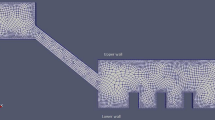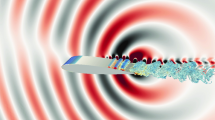Abstract
We address the capability of large eddy simulation (LES) to predict the physics of density currents interacting with bluff obstacles. Most density currents of interest in engineering and geophysical applications interact with obstacles or topographic features. Validating LES solutions in these contexts is crucial to establish it as a trusted tool. We thus propose a validation effort based on simple geometries that nonetheless pose challenges common to more complex systems, including boundary layer separation and convective instabilities. We focus on lock-exchange gravity currents in the slumping phase interacting with an emergent vertical circular cylinder. Our main investment was in ensuring that the comparison of experimental data and numerical results include, at least, the velocity and the density fields , and derived quantities (e.g., second order moments). Measurements of both density and velocity fields were performed in the side and plan views for cylinder Reynolds numbers, \(Re_d\), in the range 1300 to 3475. It was found that the LES accurately predicts the temporal evolution of the current front position. The computed front velocity exhibits a maximum relative error less than 8%. A good agreement between the LES and the experimental size and shape of the current head, and billows was found. The overall features upstream the cylinder, including a reflected wave, adverse pressure gradient and backflow, and downstream the cylinder, including the backflow, wake and the formation of a new head are well reproduced by LES. The agreement between the LES and the experimental time-space evolution of current spanwise- and depth-averaged density contours and the instantaneous velocity fields are not affected by \(Re_d\).






















Similar content being viewed by others
References
Adduce C, Sciortino G, Proietti S (2012) Gravity currents produced by lock exchanges: experiments and simulations with a two-layer shallow-water model with entrainment. J Hydraul Eng 138:111–121
Bardoel SL, Horna Muñoz DV, Grachev AA, Krishnamurthy R, Chamorro LP, Fernando HJS (2021) Fog formation related to gravity currents interacting with coastal topography. Boundary-Layer Meteorol 181(2–3):499–521. https://doi.org/10.1007/s10546-021-00638-w
Bhaganagar K (2017) Role of head of turbulent 3-d density currents in mixing during slumping regime. Phys Fluids 29:020703
Bhaganagar K, Pillalamarri NR (2017) Lock-exchange release density currents over three-dimensional regular roughness elements. J Fluid Mech 832:793–824
Bombardelli FA, Cantero MI, Garcia MH, Buscaglia GC (2009) Numerical aspects of the simulation of discontinuous saline underflows: the lock-exchange problem. J Hydraul Res 47:777–789
Boussinesq J (1903) Theorie analytique de la chaleur, vol 2. Gauthier-Villars, Paris
Brito M, Sanches P, Ferreira RML, Covas DIC (2017) Experimental study of the transient flow in a coiled pipe using PIV. J Hydraul Eng 143:04016087
Cantero MI, Lee JR, Balachandar S, Garcia MH (2007) On the front velocity of gravity currents. J Fluid Mech 586:1–39
Cenedese C, Nokes R, Hyatt J (2016) Lock-exchange gravity currents over rough bottoms. Environ Fluid Mech 18:59–73
Cenedese C, Nokes R, Hyatt J (2018) Lock-exchange gravity currents over rough bottoms. Environ Fluid Mech 18:59–73
Constantinescu G (2013) LES of lock-exchange compositional gravity currents: a brief review of some recent results. Environ Fluid Mech 14:295–317
Daviero GJ, Roberts PJW, Maile K (2001) Refractive index matching in large-scale stratified experiments. Exp Fluids 31:119–126
Ermanyuk EV, Gavrilov NV (2005) Interaction of an internal gravity current with a submerged circular cylinder. J Appl Mech Tech Phys 46:216–223
Ermanyuk EV, Gavrilov NV (2005) Interaction of internal gravity current with an obstacle on the channel bottom. J Appl Mech Tech Phys 46:489–495
Farias R (2020) Caracterização experimental da interacção de correntes de densidade com um cilindro. Master’s thesis MSc. Thesis, NOVA School of Science and Technology—FCT NOVA
Ferreira RM (2011) Turbulent flow hydrodynamics and sediment transport: laboratory research with lda and piv. In: Experimental methods in hydraulic research. Springer, pp 67–111
Fragoso AT, Patterson MD, Wettlaufer JS (2013) Mixing in gravity currents. J Fluid Mech 734
Gonzalez-Juez E, Meiburg E, Constantinescu G (2009) Gravity currents impinging on bottom-mounted square cylinders: flow fields and associated forces. J Fluid Mech 631:65–102
Gonzalez-Juez E, Meiburg E, Constantinescu G (2009) The interaction of a gravity current with a circular cylinder mounted above a wall: Effect of the gap size. J Fluids Struct 25:629–640
Gonzalez-Juez E, Meiburg E, Tokyay T, Constantinescuand G (2010) Gravity current flow past a circular cylinder: forces, wall shear stresses and implications for scour. J Fluid Mech 649:69–102
Hacker J, Linden P, Dalziel S (1996) Mixing in lock-release gravity currents. Dyn Atmos Oceans 24:183–195
Huppert HE, Simpson JE (1980) The slumping of gravity currents. J Fluid Mech 99:785–799
Issa R (1986) Solution of the implicitly discretised fluid flow equations by operator-splitting 62:40–65
Lollo GD (2021) Gravity currents interacting with an emergent obstacle. Master’s thesis MSc. Thesis, Università Roma Tre
Mahdinia M, Firoozabadi B, Farshchi M, Varnamkhasti AG, Afshin H (2012) Large eddy simulation of lock-exchange flow in a curved channel. J Hydraul Eng 138:57–70
Mariono BM, Thomas LP, Linden PF (2005) The front condition for gravity currents. J Fluid Mech 536:49–78
Meiburg E, Radhakrishnan S, Nasr-Azadani M (2015) Modeling gravity and turbidity currents: computational approaches and challenges. Appl Mech Rev 67
Ooi SK, Constantinescu G, Weber L (2007) A numerical study of intrusive compositional gravity currents. Phys Fluids 19:076602
Ottolenghi L, Adduce C, Inghilesi R, Armenio V, Roman F (2016) Entrainment and mixing in unsteady gravity currents. J Hydraul Res 54:541–557
Ozan AY, Constantinescu G, Hogg AJ (2015) Lock-exchange gravity currents propagating in a channel containing an array of obstacles. J Fluid Mech 765:544–575
Pelmard J, Norris S, Friedrich H (2018) LES grid resolution requirements for the modelling of gravity currents. Comput Fluids 174:256–270
Pereira FS, Eça L, Vaz G, Girimaji SS (2021) Toward predictive RANS and SRS computations of turbulent external flows of practical interest 28:3953–4029
Ramos JP (2021) Experimental characterization of liquid-liquid stratified flow interacting with vertical emergent cylinders. Master’s thesis MSc. Thesis, NOVA School of Science and Technology—FCT NOVA
Ricardo AM, Koll K, Franca MJ, Schleiss AJ, Ferreira RM (2014) The terms of turbulent kinetic energy budget within random arrays of emergent cylinders. Water Resour Res 50:4131–4148
Rocca ML, Adduce C, Sciortino G, Pinzon AB (2008) Experimental and numerical simulation of three-dimensional gravity currents on smooth and rough bottom. Phys Fluids 20:106603
Sher D, Woods AW (2015) Gravity currents: entrainment, stratification and self-similarity. J Fluid Mech 784:130–162
Simpson JE (1997) Gravity currents in the environment and the laboratory. Cambridge University Press
Smagorinsky J (1963) General circulation experiments with the primitive equations i. The basic experiment. Mon Weather Rev 91:99–164
Solis GN (2018) Gravity currents propagating over and within a porous bed. Master’s thesis MSc. Thesis, Università Roma Tre
Tokyay T, Constantinescu G, Gonzalez-Juez E, Meiburg E (2011) Gravity currents propagating over periodic arrays of blunt obstacles: effect of the obstacle size. J Fluids Struct 27:798–806
Tokyay T, Constantinescu G, Meiburg E (2012) Tail structure and bed friction velocity distribution of gravity currents propagating over an array of obstacles. J Fluid Mech 694:252–291
van Leer B (1979) Towards the ultimate conservative difference scheme. v. a second-order sequel to godunov’s method 32:101–136
van Sommeren DDJA, Caulfield CP, Woods AW (2012) Turbulent buoyant convection from a maintained source of buoyancy in a narrow vertical tank. J Fluid Mech 701:278–303
Zhou J, Cenedese C, Williams T, Ball M, Venayagamoorthy SK, Nokes RI (2017) On the propagation of gravity currents over and through a submerged array of circular cylinders. J Fluid Mech 831:394–417
Acknowledgements
This work is funded by national funds through Portuguese Foundation for Science and Technology (FCT) project PTDC/CTA-OHR/30561/2017 (WinTherface).
Author information
Authors and Affiliations
Corresponding author
Additional information
Publisher's Note
Springer Nature remains neutral with regard to jurisdictional claims in published maps and institutional affiliations.
Rights and permissions
About this article
Cite this article
Brito, M., Ferreira, R.M.L., Sousa, A. et al. LES validation of lock-exchange density currents interacting with an emergent bluff obstacle. Environ Fluid Mech 22, 1055–1079 (2022). https://doi.org/10.1007/s10652-022-09878-x
Received:
Accepted:
Published:
Issue Date:
DOI: https://doi.org/10.1007/s10652-022-09878-x




